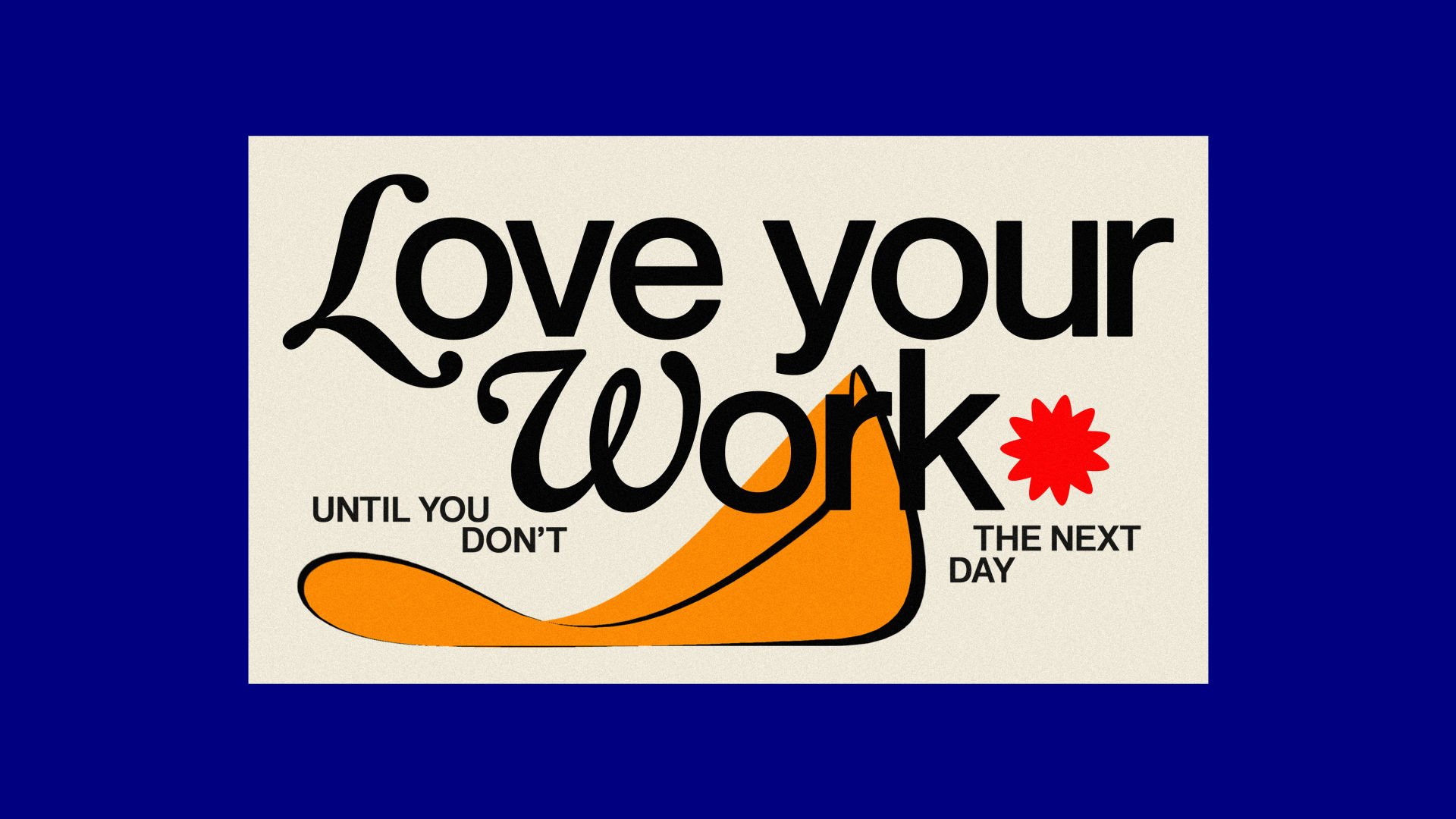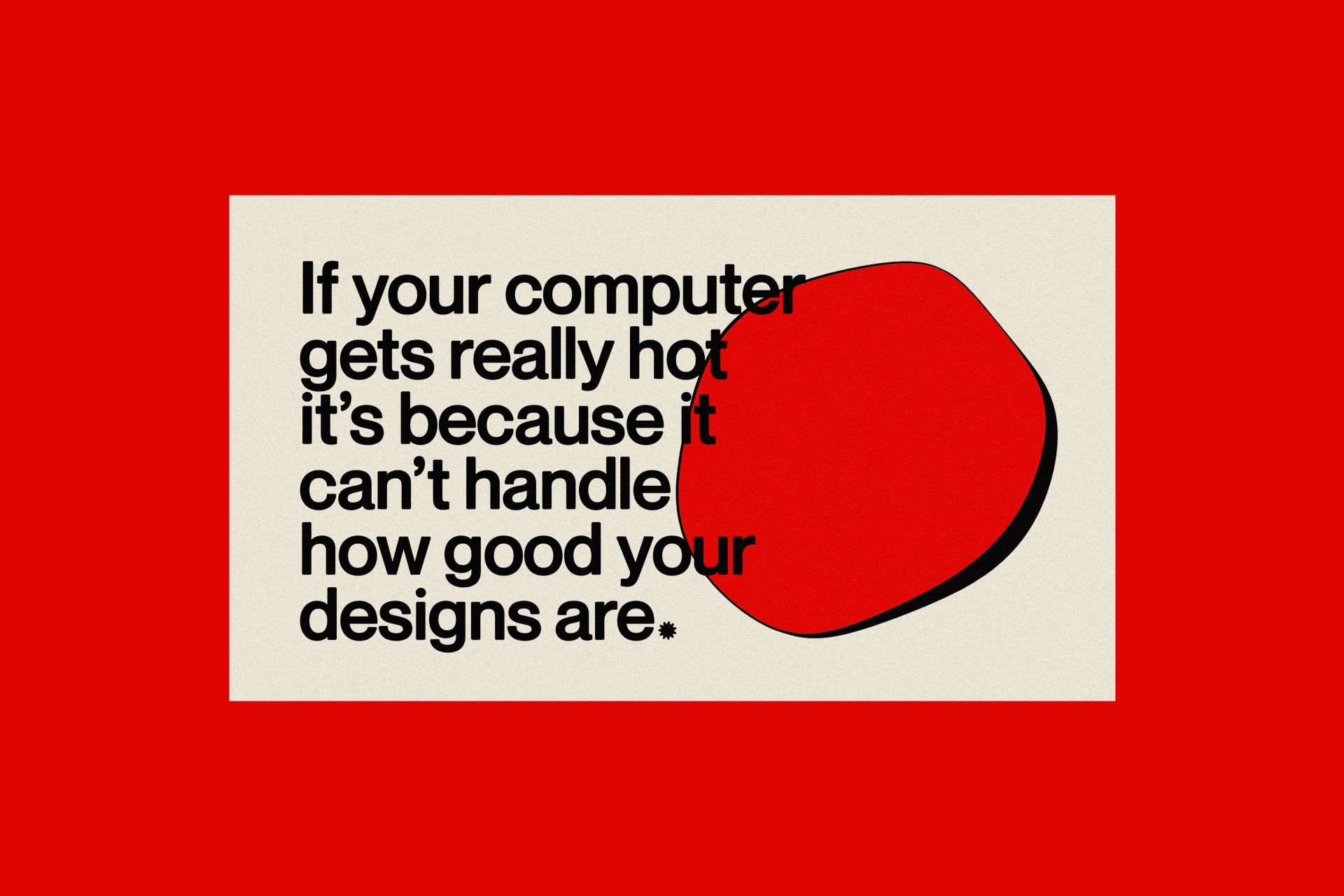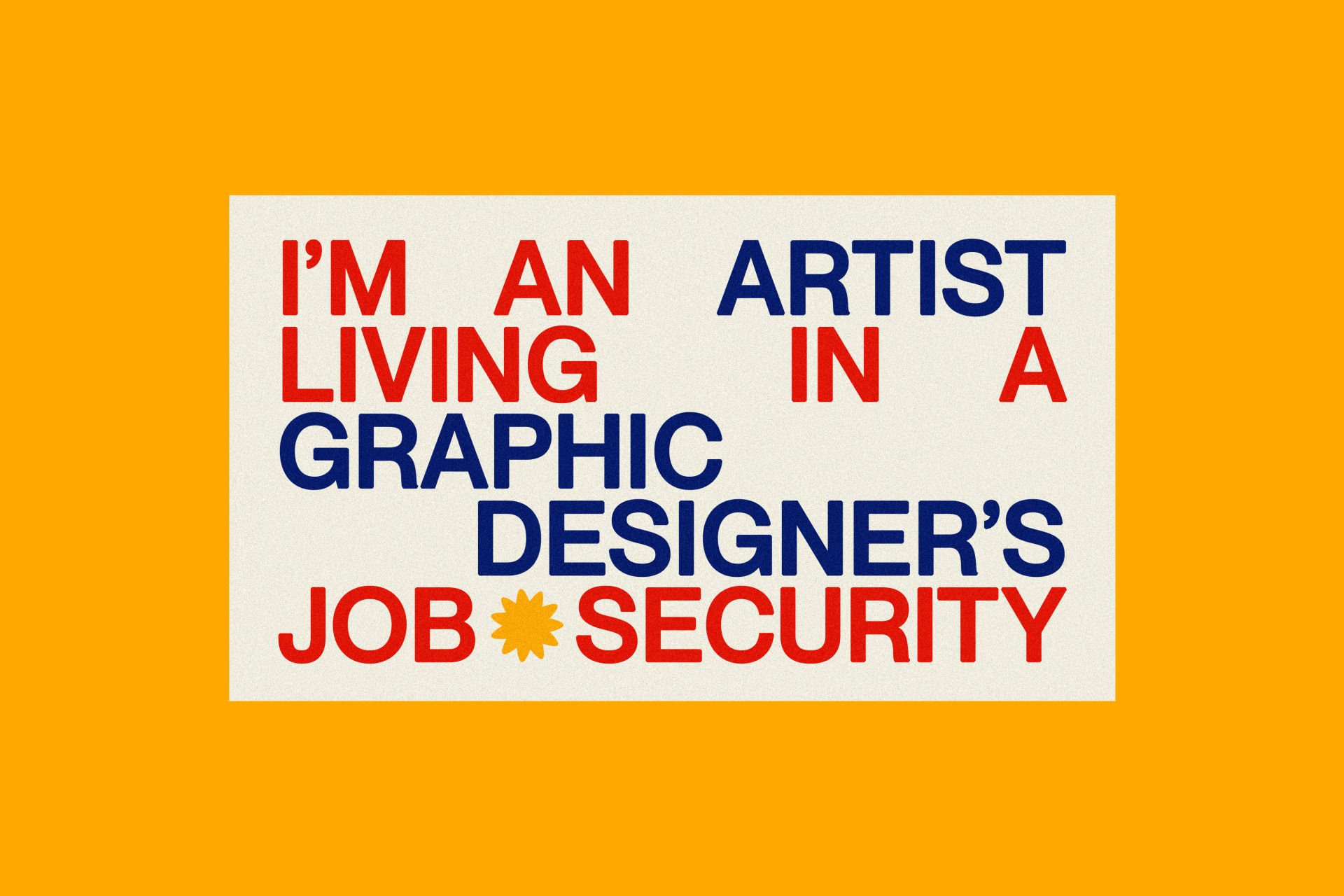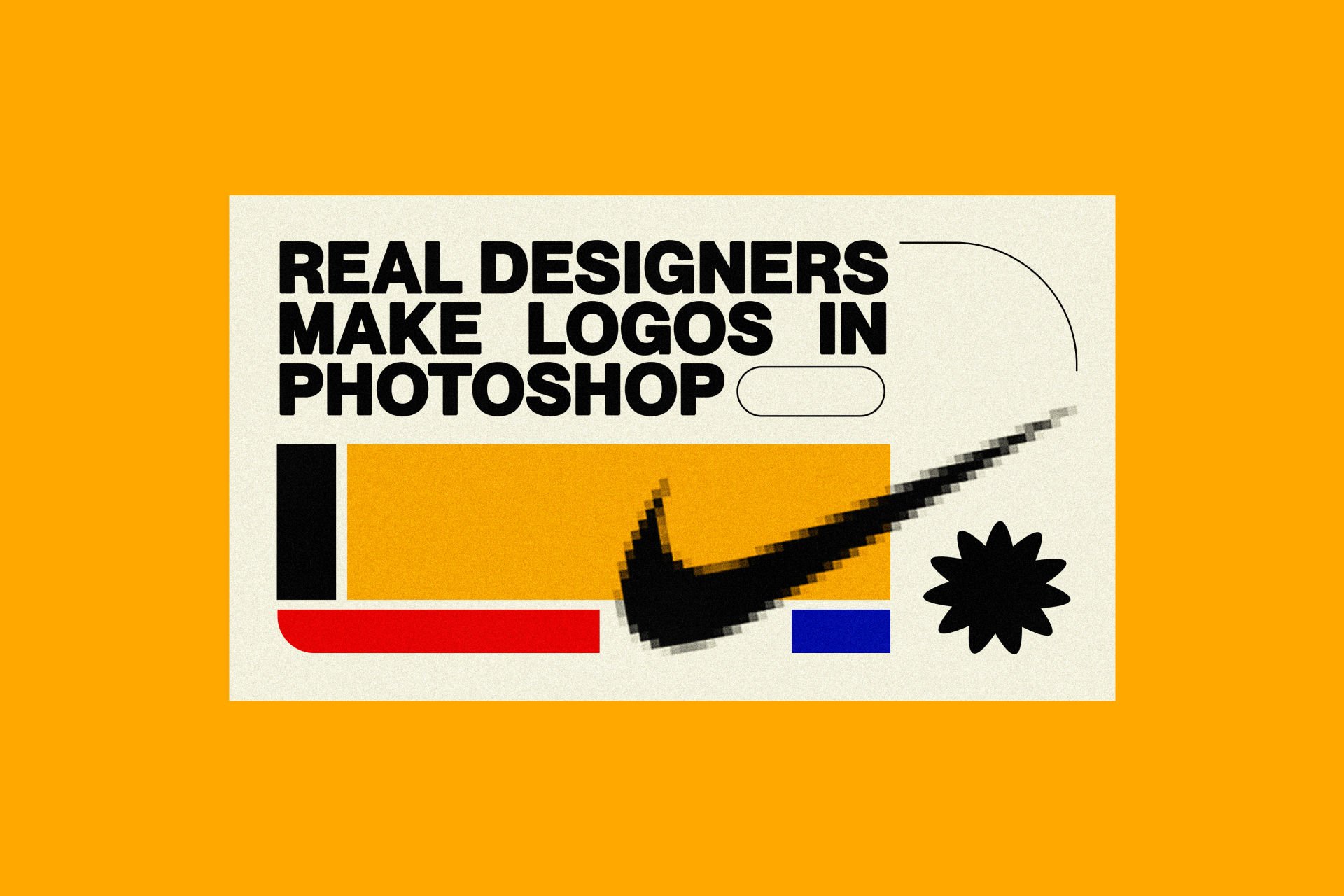In conversation with @elliotisacoolguy
Elliot Ulm is a Sydney-based graphic designer and self- titled cool guy. He’s accumulated quite the following on Instagram, presenting honest depictions of the creative experience under the handle @elliotisacoolguy. He doesn’t have a degree and he hopes that’s okay with you.
I had the pleasure of interviewing Elliot over coffee, delving into his w following, Twitch streams, design advice, isolation and bad fonts. Elliot has been able to turn his side hustle into a full-time job, as well as pitching witty commentary on the design industry.

RP: The intersection of comedy, memes and graphic
design seems to be the sweet spot your Instagram page
provides. Was this a conscious decision or a happy
accident?
EU: This was 100% conscious, I’ve done improv and acting my whole life... that’s still my dream. This is very much a side hustle that did way too well and is now overtaking my life. Basically, I wanted to post on Instagram in some sort of capacity because I saw a whole bunch of other people doing it. The main advice I got was from a British designer I admire — his name’s Harry Vincent — I messaged him through a Q&A sticker and I just said, “How do I get as many followers as you have?” He had around 25,000 at the time, and I just joked about it. He said, “I know you’re joking, but seriously just be yourself.” I was like... what does that mean? That’s such a cheesy thing to say. Since I have a comedy background, I wanted to put that into my posts in some way or another. The second post I ever did was a set of business cards: I don’t have a degree, I hope that’s okay. It was honest. I just started posting and then people seemed to like it; they were very shareable.
RP: Yeah. It’s essentially a meme page... but make it beautiful.
EU: Exactly, I personally call it honest depictions of the creative experience, but they’re 100% just memes, designed well. No one was doing it. The majority of people posting on Instagram, especially design accounts with black backgrounds, were doing cool one word designs. Like [the word] rough, with a texture on it. And I didn’t want to do that. I tried it once, funnily enough, with a mustard color, but that bombed. So I went back to funny stuff and it just picked up; the business cards came out of that. Then, people just seem to really like it. I enjoy making them so that’s good.
RP: Your graphic design page is quite witty, and you also do comedy shows. Were you the class clown in school, or is comedy something you’ve grown into?
EU: I was a really awkward kid up until year eight. We had compulsory drama class at my school. In that, there was an improv exercise, called Speed Ball, which is a super simple game. You just tap someone out and you do a scene with somebody else. It took me three terms to have a go at it. As soon as I did, I got a laugh and I was like... oh my God. It was the best feeling ever. I’m funny. I don’t know if I was the ~ class clown ~ class clown. I was just having a bit of fun.
I’ve done a lot of improv, that’s kind of where it crosses over to Twitch. Because I get instant validation in the chat if the joke is funny, and I’m just making it up as I go. Whatever happens, happens. Improv just carried me. It helps so much with confidence and everything else — that’s kind of what I credit my success to. Do improv, everyone.
RP: Your page really blew up over the last year. And I think as designers, we talk about this broader notion of ‘The Industry’, and I know you’ve made quite a few jokes about it. What role do you think your followers play in your career and feeling like you belong in the industry?
EU: Well, when I started designing and tried being a freelance graphic designer in early 2019, I had no idea what I was doing. I didn’t even know how much to charge for my work. I would charge $50 for an entire comedy festival, including posters and Instagram content. I didn’t have anyone to ask. I think it’s good having a page that attempts to be honest and break down those kinds of barriers which prevent people from getting into the industry.
I think I have a close relationship with my followers, which is cool. I try to communicate as much as possible and answer any questions. I want to be the guy who I didn’t have. I’ve got a few friends now, a few designer friends, around the area who are 30+ and they’re getting work with Nike, Adidas — all that stuff. I asked them how much I should charge for a project. I got a response and it was like 10 times more than I was charging at the time, but it was the industry standard. When I started charging that, people paid. I needed someone to tell me that three years ago. I’m trying to encourage everyone, through my work and conversations, to eventually [and] hopefully raise the standards for all graphic designers.
RP: I’ve noticed that you’ve started streaming your design process on Twitch while chatting with your followers and design community. Did this transparency make you feel vulnerable, or were you unphased?
EU: Completely unphased. I don’t think every work I make is a masterpiece. Whether I’m designing on Twitch [or] on Photoshop, I don’t care. It works. I don’t put 100% of my effort into each post. I’d like to think the whole page is the post — my art, in a way — rather than each individual post. So that takes the pressure off. If a post bombs, it bombs, whatever. It’s the whole experience, the journey that got me here that is more important. It’s just a good way of being completely transparent. Very much from the start to the finish of a project, I ask them questions about how much I should charge. I’ll tell them about it, unless I’ve signed an NDA. I think it’s good if I’m 100% open, transparent, and completely ready to take on any criticism. I feel like it helps other people.
RP: That’s a really nice outlook to have. Can you explain your Design Chef challenge, and how it started?
EU: One of my Twitch members suggested that I run a challenge, because I’m all about designing for fun, rather than designing for other people. I’m a big believer in that’s how you get better. And they were like, “Well, let’s do it together. Like on Twitch.” That’s how Design Chef came around, it’s a bi-weekly challenge where I give a suggestion, we complete it together, and I review it at the end. I’ve made a personal rule that I do not criticise anyone. It’s literally just validation. I would praise the work no matter what it is. Even if I think it’s the worst thing in the world — which I do not, because they’re very talented people — I’ll praise it because I think people just need to hear that sometimes.
Criticism is just a huge thing as well. You can make something on Instagram and someone gives criticism that you didn’t ask for. No one wants that. I think that people can get really brought down by that kind of stuff. Especially when clients give criticism and you’re just starting out, that can really make you feel shit as a designer.
And then you get Design Chef where you can see your work on screen and there’s 70 people in the chat all saying, “Bless, this is amazing,” and “Oh my God, I think this is so good.” It gives people a little bit of inspiration. That’s what it’s all about. It’s just for fun. There’s no prize or anything. You get a little badge next to your name for the season and that’s it. It just reminds people to design for themselves, have a bit of fun, take risks, and experiment in an opportunity that they wouldn’t get if they were only doing client work.
RP: As someone who makes a challenge out of trying to use bad fonts to create good designs, what are your favorite and least favorite fonts of all time?
EU: My favorite font is one that I’ve pretty much used in every single post in the last eight months — Neue Montreal, by Pangram Pangram Foundry. I use that in everything. I will also always have a soft spot for Papyrus... I think it gets way too much shit. Comic Sans is the same. If you’re making fun of Comic Sans these days, what are you doing? Read a book or something. Curls MT is my least favorite font by a long mile — I just can’t do it. There’s just something about it. Also, I’m not really a fan of Helvetica. My alternative is Neue Montreal; it’s the subtle, subtle differences, [but] Neue Montreal wouldn’t be around if it wasn’t for Helvetica, so I do respect that. But yeah, Curls MT? Never, never.

If you’re making fun of Comic Sans these days,
what are you doing?
which is a horrible pressure, but I love it. But what I don’t like about client work is the pressure. I’m just not good with that. I’m sure plenty of people suffer from imposter syndrome, but it’s the worst. Especially when you’re making a design and charging more than you usually would. Now, you’re worrying that you’re not worth that price. I feel that every single time. For my collaboration with Linktree, I charged so much more than I’d ever imagined for each business card. I thought they would hate it. Then, I sent it to them and they absolutely loved it. It turned into an amazing partnership with Twitch. I think I find that I work better when I’m just doing it for myself without the pressure, or the only pressure is just a timeline. It’s interesting to have clients that want me to design for them in the way that I would design for me. They like my style and they want me to make business cards and funny stuff. So, it comes back to the advice I got about being yourself, even when you’re designing. I just have to make sure that whenever I’m working with clients, I’m sticking to what works for me, I’m not designing [just] for them. It’s a collaboration.
RP: So what role do you think you have in the industry, and what can people expect to take away from consuming or engaging with your work?
EU: I’d like to think that I’m helping. I feel like I’m a corner of joy in the design industry, because I noticed a lot of people on Instagram weren’t revealing what fonts they use or which techniques they would do. There’s no point, because the only people who are really looking at your work are graphic designers; 99% of other graphic designers’ followers are graphic designers. So the fact that they hide all their secrets never made any sense to me. The more open you are, the better we all get. That’s important. As soon as you become secretive about your techniques or fonts, it just becomes competitive.
Now I’m trying to get more serious and joke about things that actually have more of an impact on the industry, rather than just saying, “Haha. Font bad. Lol.” Or, “Got paid in exposure again”. I want to talk about things that are very much real. Things that a lot of people don’t realise are bad. Unpaid internships are straight up illegal in the UK, except people think it’s fine because of experience. But, how many hours are you putting into this? What if you couldn’t afford this? You’re getting an opportunity that someone else can’t. This is why it’s illegal in the UK. Maybe here, people just don’t know how damaging that stuff can be.
I hope that I can be some sort of inspiration for young designers, especially self-taught ones, because I never went to school for design. I want to show there’s a pathway to a successful graphic design career just through social media. Now that I post on Instagram and have made this page, treating it as my art, people hire me for it. That’s an option that I think a lot of people don’t realise. They could actually get commissions for their design work rather than just an hourly rate. I hope I’m a little bright corner somewhere.
RP: Yeah, I think so. What kept you sane during iso, what drove you mad, and is there anything that helped you heal?
EU: [My Instagram] page helped so much, because everyone was online so much. So that really, really, really helped the page. I also had an audition at the start of the year…just trying to make it, you know, whatever. I was just going to open auditions and I had the best audition of my bloody life, a week before theaters shut. That got me really down for a while and I couldn’t do any acting over iso.
I think if I focus 100% on design, I get really bored of it. And that’s what started happening. I was like, “I’m done”, I’m seeing that this can’t be it. Which is why Twitch is good because it’s kind of performing.
Having the Twitch community has helped me a lot. I have a Discord now of 600 people where they can ask questions, get advice, and promote their work. We had a Netflix watch party the other week. I’ve had a lot of voice calls with them because they’re mostly in America and their situation is horrible right now. They’re all staying inside, or trying to, so it’s nice being able to talk to other people in a similar situation. Having that community, being able to run it and organise all this stuff and knowing that I’m keeping other people’s minds occupied is a nice feeling. It’s fine because it’s a lonely time [and] being a graphic designer can be very, very boring.
RP: Especially as a freelancer, at home by yourself...
EU: 100%. Design school and design events are amazing because you can meet so many people and network. But, if you’re a freelancer, you don’t get those opportunities unless you really look for them. I was always too awkward to go to any design events because I was only 19. I didn’t know what I would say. I wasn’t very good and I had no idea what I was doing. Having an online community for designers who are, in general, very awkward, I think really helps, especially when it’s so global. You learn that globally, people are going through the same minor issues in the design world and have the [same] industry standards. I think being able to compare your experience with someone else’s and then using that experience to assist you in where you go with your career is really helpful. There’s a lot of really experienced people active on my Discord now, answering questions and putting in so much time and effort that I wouldn’t have believed. I really appreciate that, and they’re helping it become a really important space.

People [globally] are going through the same minor issues in the design world..
RP: What was the biggest thing that 2020 taught you?
EU: Good question…I spent a lot of time online last year because I was making this page. Through April to now, I’ve only missed one Friday games night with my friends. Whether it was on Zoom or in person, we made it to every single one. I appreciate having that as part of my routine [and] having a group of people to hangout with.
I didn’t realise how much time I actually spent thinking about design and working on design. I still don’t get paid for anything I post on Instagram. It’s all completely unpaid. It’s all about converting into Casetify sales and into Twitch subscribers, which has been working, but I still don’t get paid for posts. I spent a lot of time on that page with my community, but having real people to interact with in front of me was a really, really good thing.
This year, I’m going to actually treat this as my job, rather than just my side hustle that worked out. This is full-time now. I have set hours. I get weekends. I can think about acting when it comes up. [I’m] kind of separating my life like that, rather than just incorporating everything into the design side of my world. So that’s something I’m working on more this year.
My page was originally a personal page because I didn’t want to start from zero. I wanted to start from 500. I highly recommend that to everyone. Just change your personal [Instagram page] and you’ll realise who your real friends are. Separating is really important. I didn’t realise how important that would be.


 -
-